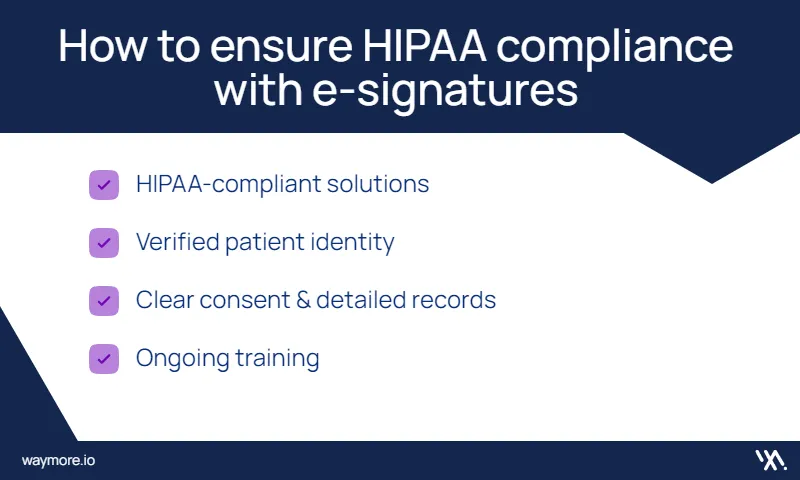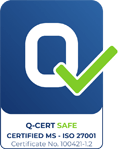Quick Links
The world of healthcare is changing fast! With more and more people using telemedicine (seeing a doctor virtually), giving treatment securely is super important.
This blog post will explain why e-signatures healthcare compliance is becoming a big deal.
E-signatures & HIPAA compliance
Remember those mountains of paper documents at the doctor’s office? Say goodbye! Electronic signature solutions for healthcare (e-signatures) are making remote patient consent procedures easy.
Patients can safely approve treatment plans online with digital documents and e-signatures. This ensures that their electronic health records (EHRS) stay secure and follow HIPAA rules.
This move to digital doesn’t just make things easier, it also helps improve digital health overall. Healthcare is now more efficient and convenient for everyone involved.
Building trust and security
Ensuring secure patient consent is paramount in telemedicine. HIPAA-compliant e-signatures offer a solution that mirrors the security measures you employ on social media platforms for your practice.
Digital signature platforms for healthcare utilize cutting-edge features to address security concerns with digital signature platforms for healthcare medical records. Encryption, essentially a “secret code,” scrambles patient consent forms (electronic documents) before transmission and storage, rendering them unreadable to unauthorized individuals. Additionally, authentication acts like online ID verification, guaranteeing only authorized patients can sign the forms.
These features work in tandem to create a robust security system for sensitive patient data, protecting health information. Digital signature platforms for healthcare go beyond by incorporating strong healthcare data security measures, like digital certificates. This not only protects health information (PHI) but also fosters trust within the doctor-patient relationship.
By utilizing HIPAA-compliant e-signatures, you can ensure regulatory compliance with HIPAA (Health Insurance Portability and Accountability Act), the law governing medical privacy, while streamlining the telemedicine consent process for both you and your patients.
The growing e-signature market

According to Fortune Business Insights, the global e-signature market was valued at USD 5.25 billion in 2023 and is expected to grow to USD 7.04 billion in 2024.
By 2032, the market is projected to reach a staggering USD 66.01 billion, reflecting a Compound Annual Growth Rate (CAGR) of 32.3% during the forecast period.
This significant growth in healthcare industries highlights the increasing adoption of e-signatures across various industries, including healthcare.
Benefits of e-signatures in telemedicine
E-signatures offer several advantages over traditional paper-based consent forms in telemedicine:
- Increased Efficiency: E-signatures streamline the consent process by eliminating the need for printing, scanning, or faxing paperwork. This saves time for both patients and healthcare providers.
- Enhanced Security: E-signatures use strong encryption and authentication methods to ensure that only authorized individuals can sign consent forms. This helps to protect patient privacy and prevent fraud, even on mobile devices.
- Improved Accuracy: E-signatures eliminate the risk of errors that can occur with handwritten signatures or mistyped information.
- Boosted Transparency: E-signatures create a clear and verifiable record of the consent process, including the date, time, and identity of the signer. This can be helpful in case of any disputes or audits.
- Creation of Audit Trails: As mentioned previously, e-signatures create verifiable audit trails that can be reviewed in case of any questions or concerns. This adds another layer of trust and transparency to the telemedicine process.
E-Signatures best practices for doctors
E-signatures offer a secure and efficient solution for patient consent management. Implementing this new technology requires following best practices to ensure regulatory compliance, data security, and a smooth patient experience.
Here’s are the best practices for e-signatures in healthcare which will optimize your use of e-signatures:
Online signature verification
Online signature verification means using tools to check if the person giving consent is actually the right person before they sign electronically. This helps prevent someone from pretending to be someone else and makes sure the consent is legally valid.
Clear Communication & Detailed Records
Make sure patients understand what’s going on by explaining procedures clearly before they sign electronically. Keep careful electronic records of the whole e-signature process, including when things were signed and any changes made, so you can refer back to them later if needed.
Robust Security Protocols
Choose a reliable e-signature platform, like WayMore.io, that meets strict HIPAA compliance standards. These platforms function as secure digital vaults for patient data, utilizing robust encryption and secure storage protocols. Additionally, they enforce granular access controls, ensuring only authorized personnel within your practice can access patient information.
Ongoing Staff Training
Regularly train your staff on both HIPAA regulations and proper e-signature protocol. This ensures everyone understands the process, can answer patient questions confidently, and adheres to compliance standards.
By following these best practices, you can leverage e-signatures to streamline your workflow, enhance patient privacy, and build trust within your practice. E-signatures offer a win-win situation, improving efficiency while ensuring regulatory compliance and patient data security.
How to implement e-signatures for healthcare compliance
Transitioning to e-signatures in healthcare requires careful planning, similar to setting up a new software.
Selecting a reliable digital signature platform is key. Think of it like selecting a high-security lock for your practice’s digital door.
This ensures patient data remains secure and adheres to strict healthcare regulations (ensuring Regulatory Compliance with electronic signature solutions in healthcare).
This includes following both compliance with e-signature laws, like the Electronic Transactions Act (UETA) and streamlining your e-prescription workflow.
The good news? E-signatures can significantly enhance telemedicine! By utilizing secure digital signatures in healthcare, you can streamline the telemedicine consent process, allowing patients to receive care faster.
Additionally, integrating these e-signature solutions seamlessly with existing telemedicine systems further optimizes workflow.
This translates to a win-win: a more efficient way for your practice to deliver care and a smoother experience for your patients.
How to ensure HIPAA compliance with e-signatures

Here are the Best practices for managing patient consent with e-signatures:
HIPAA-compliant solutions
Pick e-signature platforms that follow strict HIPAA rules. These act like super-safe digital lockers that include information, using strong encryption (which is like scrambling data) and safe storage rules. Plus, they only let the right people get into patient records, so your info stays private and secure.
Verified patient identity
Implement procedures to verify patient identities electronically before capturing e-signatures on consent forms. This confirms you’re obtaining consent from the authorized individual who is signing a document.
Clear consent & detailed records
Make sure you get clear permission from patients before any procedures. Keep careful electronic records of the whole e-signature process, including when things were signed and any changes made, so you can refer back to them later if needed.
Ongoing training
Regularly train staff on both HIPAA regulations and proper e-signature protocol. This ensures everyone understands the process and adheres to compliance standards.
By following these best practices, you can securely leverage e-signatures in telemedicine while safeguarding patient privacy and ensuring HIPAA compliance. This translates to a more efficient workflow and improved patient experience.
Safe data & optimized workflows
Data breaches are a concern, but secure e-signatures for telemedicine can help mitigate those risks. These platforms are like digital safes for patient information, using strong encryption (data scrambling) and secure storage methods, following legal requirements. Additionally, they enforce granular access controls, ensuring only authorized personnel can access patient information. This two-pronged approach of strong encryption and access control safeguards sensitive data and helps you achieve HIPAA compliance.
Beyond security, secure e-signatures streamline the telemedicine workflow. Online identity verification ensures that only the intended patient signs consent forms. This eliminates the risk of errors or fraud associated with traditional paper forms. Furthermore, e-signatures create verifiable audit trails, simplifying recordkeeping and potential audits.
By implementing secure e-signatures, you can:
- Enhance Patient Data Security: Robust encryption and access controls minimize the risk of data breaches.
- Simplify HIPAA Compliance: Streamlined workflows and verifiable audit trails make adhering to HIPAA regulations easier.
- Boost Efficiency: Online identity verification and digital forms save time compared to paper-based processes.
Secure e-signatures offer a win-win for both you and your patients. They improve data security and streamline workflows, ultimately leading to a more efficient and secure telemedicine experience.
Streamline your telemedicine practice with secure e-signatures
Managing patient consent in telemedicine can be a time-consuming hassle. But what if there was a way to make it fast, secure, and user-friendly? That’s where secure e-signatures come in. Think of them like digital signatures that act like a powerful security system for your patients’ medical information.
Benefits for you and your patients
- Enhanced Security: Just like online banking uses strong security standards, e-signatures scramble patient data (encryption) and restrict access only to authorized personnel in your practice. This significantly reduces the risk of data breaches, keeping patient information safe.
- Simplified Workflows: Say goodbye to mountains of paperwork! E-signatures allow patients to securely approve treatment plans electronically, saving you and your staff valuable time. No more printing, scanning, or faxing documents!
- Reduced Errors: Forget about struggling with illegible signatures or typos! E-signatures eliminate the potential for errors associated with traditional paper forms. This ensures clear and accurate patient information.
- Clear Audit Trails: E-signatures create a clear and verifiable record of who signed what and when. This makes audits a breeze and ensures everything is documented properly, reducing potential headaches down the road.
E-signatures are a game-changer for telemedicine. They offer a secure, efficient, and user-friendly way to manage patient consent. This translates to a smoother experience for both you and your patients, allowing you to focus on what matters most – providing excellent patient care.
The truth on e-signatures
The “true story” behind e-signatures in healthcare compliance is one of efficiency and security. They streamline workflows, eliminate paper mountains, and ensure HIPAA compliance with robust encryption and verification.
E-signatures are the secure solution for telemedicine consent
No longer a question mark, e-signatures are the secure solution for telemedicine consent, empowering a smoother future for your practice.
Curious to learn more? WayMore’s experts are ready to chat!




